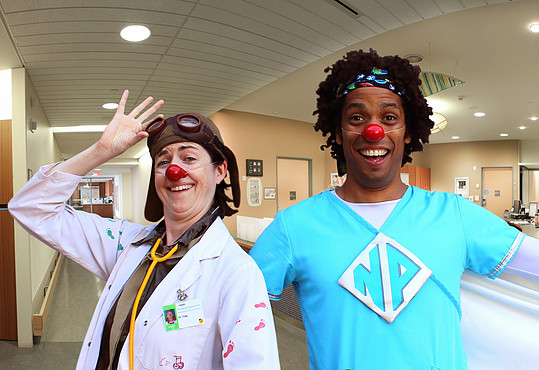|
Yes! A practical and generous workshop lead by, amongst others, the brilliant Helen Donelley and her brilliant partner in hospital clowning, Manuel Rodriguez Saenz (Aka Dr Flap and Nurse Polo). They work at the Holland Bloorview Kids Rehabilitation Hospital in Toronto 3 times a week with a Therapeutic Clown programme, and come across a lot of teenagers who they build long-term relationships with. Did I mention that they are both brilliant?
I am always frustrated that staff often back-off from referring us to Teenagers. I love Teenagers. The most effective way of us getting those referrals, is by having effective interactions. The more of those we have, the more confidence we will have in insisting to staff that we can give it a go. Here are some fun games from the workshop and some from conversations afterwards (some of them you will know...are there more? please share too!) All of these games can start indirect, with no demands put on the client, and built accordingly - over one visit, or over weeks or even months. A few of these play with the No. Of course we respect the No. But we also know that there are No's and there are NO's. And sometimes there are No's that are Yes's. Play the long game. Deliveries Very simple. Clown 1 asks the client to sign for a delivery, very low key, while clown 2 enters the room with an object. Start small - something from the hospital - an apron, sick bowl, blue glove. This can build up beautifully with bigger and more absurd objects- like a nurse on a chair. Totally love it. Club Enter the room as if it is a really loud club. Can't hear each other, shouting over the noise, dancing. You can bounce in, and if you get a clear 'No', you can bounce out again, 'Sorry...wrong Club!'. Such a nice way of being light and in the world of clown as well as acknowledging the age and interests of the client. Who's more cool? A conversation/arguement starts between Clown 1 and 2. The only person who can settle it is the client. Again, this can be totally indirect, even a few times before the client is involved. Not going in the room Enter the room just to make it clear that you are not going to enter the room. iclown Presenting ourselves as the latest iclown technology, complete with downloadable apps. Nice game with opportunities for physical play and the pay-off of the clown being good at something Renting the room Enter the room, chatting in partnership about size, pacing it out, discussing decor etc Mistaking the Teenager for a baby Checking paperwork, indirect conversation about how big it is for a 6 month old etc Escaping from all the babies Some things that occurred to me during this session that I need to keep in mind. It is nice to receive compliments, whatever your age. If you are anxious, the client will be anxious. It is more than probable that they will see themselves as the source of your anxiety, which isn't a nice feeling. Be age appropriate. You can still totally inhabit the world of the clown without being patronising about the things that are important to The Client. Respect their love of pop music or film stars or clothes or whatever it might be. What have I missed, clown friends?
0 Comments
Leave a Reply. |
AuthorI am a therapeutic clown and performer. Writing here is part of my wider practice and maybe some of my thoughts will trigger some thoughts of your own and I hope that helps. Archives
May 2024
Categories |

 RSS Feed
RSS Feed